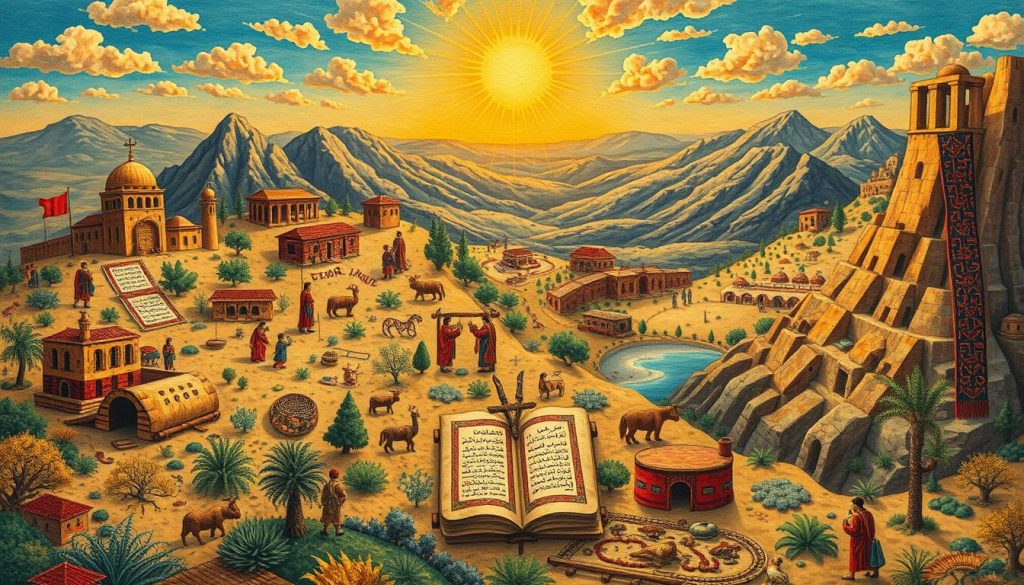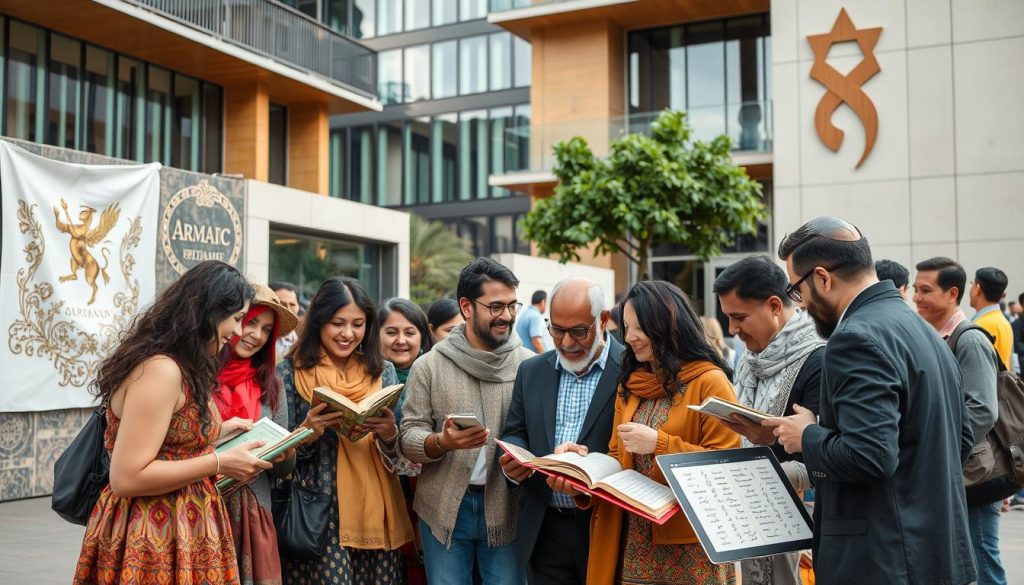Aramaic: The Ancient Language of Jesus.
Aramaic is a captivating ancient language with deep roots in linguistic history and Jesus’ life. Scholars agree that Jesus mainly spoke Aramaic, the common tongue in Roman Judaea. This historical language was widespread in places like Nazareth and Capernaum.
Anúncios
It’s believed Jesus spoke a Galilean dialect of Aramaic, different from Jerusalem’s. This dialect was unique to his region.
This article delves into Aramaic’s origins and cultural importance. It shows how it remains relevant today, influencing cultures and religions. Aramaic was crucial for Jews in the Holy Land until about 200 AD, when Greek became more common. We’ll look at its lasting impact in the sections that follow.
Introduction to Aramaic
The Introduction to Aramaic gives a deep look at the Aramaic language and its past importance. It started in Mesopotamia and became a key language in many empires. This was especially true during the times of the Assyrians and Babylonians.
By the sixth century BCE, Hebrew speakers began using Aramaic more. This change was big for how people talked in the area.
Anúncios
Over time, Aramaic showed many similarities to Hebrew. They shared an alphabet and roots. This made it easier for Hebrew speakers to use Aramaic every day.
Aramaic became a common language, especially among Jews in first-century Palestine. It was the main language people spoke.
About 200 Bible verses are in Aramaic, mostly in Ezra and Daniel. Ezra 4:6-6:18 and Daniel 2:4-7:28 have a lot of Aramaic. Even a sentence in Jeremiah (10:11) and two words in Genesis (31:47) show its use in the Bible.
Though the Gospels are mostly in Greek, they keep many Aramaic parts. This shows how important Aramaic was for early Christianity.
Aramaic stayed important through history. It’s seen in the Dead Sea Scrolls, rabbinic writings, and Targumim. Even into the eighteenth century, Aramaic was used in legal and mystical texts. The Syrian church still uses a dialect called Syriac, showing Aramaic’s lasting impact.
Aramaic: The Common Language of Jesus’ Time
In Jesus’ time, Aramaic was the main language spoken in the Eastern Mediterranean. It was used every day by people. Jesus and His followers spoke Aramaic, which was their main way of talking. Most scholars believe Jesus spoke the Galilean dialect, different from Jerusalem’s.
After the Babylonian exile around 586 BCE, Aramaic became more common. By the Second Temple period, which ended in 70 CE, it was usual for people in Palestine to speak Aramaic. The New Testament shows Jesus’ last words on the cross were in Aramaic. This shows how important Aramaic was in Jesus’ time.
Jesus knew Hebrew for religious talks, but Aramaic was key for Him. Sometimes, He spoke Greek with outsiders. Scholars argue if Jesus mainly spoke Aramaic or Hebrew. But most agree Aramaic was the common language among Jews.
Even though Greek was used for business and government, most Jews spoke Aramaic every day. Jesus and His community were deeply rooted in Aramaic culture. Hebrew was important for religious texts. This mix of languages helps us understand Jesus’ message and the society He lived in.
| Language | Usage Context | Remarks |
|---|---|---|
| Aramaic | Daily communication among common people and disciples | Primary language of Jesus; pervasive in Galilee |
| Hebrew | Religious discussions and texts | Necessary for understanding Scriptures; less spoken in daily life |
| Greek | Administration and commerce | Used in interactions with authorities; some exposure among rural populations |
The Dialects of Aramaic
Aramaic has many dialects, shaped by history and geography. Galilean Aramaic is key because Jesus spoke it in the areas he lived and preached. It’s different from the dialects of cities like Jerusalem, showing the variety in Jewish communities back then.
Dialects of Aramaic show how different groups interacted in first-century Judea. As Aramaic became the main language among Jews, around the 6th century BCE, these dialects developed. They have their own words and ways of speaking. Over time, Aramaic has changed a lot, from ancient to modern forms.

Studies show Aramaic dialects split into East and West types. West dialects include Nabataean and Palestinian-Christian. East dialects are Syriac and Mandaean. This shows how different places led to different dialects.
Today, some of these dialects still exist, especially in small communities in the Middle East. This shows how important Aramaic dialects are to these communities. Studying these dialects helps us understand the history and culture of the Middle East.
Evidence of Aramaic in the New Testament
The New Testament shows many *Aramaic phrases* that Jesus used. The phrase “Talitha kum” shows the language and culture of Jesus’ time. The New Testament was mainly written in Greek, but Jesus’ teachings were likely in Aramaic first.
The Peshitta, an early New Testament translation, is key. It has 22 books and shows how *Aramaic phrases* were used in early Christian texts. It has some verses not in Greek, but includes the ‘long ending of Mark’. Scholars believe Jesus’ teachings were kept in both Greek and Aramaic.
Many early Christians could speak both Aramaic and Greek. This helped in translating Jesus’ teachings into Greek. The Greek New Testament has Aramaic words, showing its importance in telling Jesus’ story.
| Feature | Description |
|---|---|
| Language Origin | Aramaic phrases were likely spoken by Jesus. |
| Peshitta | Contains 22 books, key Aramaic phrases and modifies Greek texts. |
| Bilingual Context | Early followers likely spoke both Aramaic and Greek. |
| Significance of Phrases | Aramaic phrases serve as insights into historical traditions. |
| Scholarly Consensus | Majority of the New Testament originally in Greek with Aramaic influences. |
Understanding *Biblical language usage* is still a topic of study. It shows how New Testament Aramaic adds depth to early Christian texts. This study is important for grasping the role of Aramaic in the New Testament.
Aramaic’s Cultural Significance
Aramaic is more than just a language; it’s a tradition filled with history. For ages, it has been key in religious practices, especially in Judaism and Christianity. It was used in sacred texts and during important rituals, shaping community identities.
In religion, Aramaic has deeply shaped many cultures. It was Jesus’ language and is found in the Bible, like in Daniel and Ezra. Phrases like “Talitha koum” and “Eli, Eli, lema sabachthani?” show its lasting impact in the New Testament.
Aramaic literature also adds to a vast collection of writings. The Babylonian Talmud, written mainly in Aramaic, holds deep discussions crucial for Jewish studies. This shows Aramaic’s ongoing importance in both academic and theological fields.
Despite challenges, like displacement and language loss, efforts to keep Aramaic alive go on. Classes and books aim to teach it to the young, keeping its cultural impact vibrant. Learning about Aramaic’s role in religion and literature honors the past and guides us through today’s changing world.
Modern Relevance of Aramaic
Modern Aramaic is still important, even though it’s less common today. Assyrian and Chaldean groups keep the language alive with their dialects. About 600,000 people still speak it, showing a deep cultural connection that lasts through time.

Keeping modern Aramaic alive involves education and cultural events. Programs work to make the language appealing to young people. This way, they can connect with their heritage. Many see Aramaic as a key part of who they are, helping them feel connected to their past.
- Eastern Aramaic (e.g., Assyrian Neo-Aramaic) and Western Aramaic (e.g., Jewish Palestinian Aramaic) are among the significant dialects still in use.
- Efforts for language revival include an estimated 5 to 10 academic programs dedicated to teaching Aramaic globally.
- Language learning technologies, such as around 75 apps, support Aramaic education and accessibility.
Despite a 30% drop in speakers over a century, efforts to save Aramaic are ongoing. Communities celebrate their language, showing their dedication to keeping it alive.
Aramaic Translations of Sacred Texts
The study of the Bible has been greatly influenced by Aramaic translations, especially the Peshitta. This Bible version in Aramaic is key for Eastern Christian groups. It connects them directly to Jesus’ original words, keeping early Christian teachings intact.
Since 2010, translating Aramaic scriptures has made big strides. Scholars have looked at Eastern Aramaic texts from different eras. This confirms the accuracy and depth of these translations.
| Century | Manuscripts |
|---|---|
| 5th-6th | Goodspeed MS 716, others from Saint Catherine’s Monastery |
| 7th | The Yonan Codex |
| 8th-9th | Paris Syr. 342 Codex |
| 10th-11th | Vat.510 manuscript |
| 12th-13th | 1199 A.D. Houghton Codex, 1261 A.D. Syr. 9 Codex |
| 17th | 1613 A.D. Mingana Codex (“The Textus Receptus”) |
The translation work is thorough, using many manuscripts but no Greek or Latin texts. This makes Aramaic interpretations unique. It helps us understand Jesus’ teachings better.
Today, translations like George Lamsa’s and the Aramaic English New Testament are available. They show how Aramaic differs from Greek versions. For example, Matthew 19:24 talks about “a rope” in Aramaic but “a camel” in Greek.
More audio recordings of the Gospels are being made. This helps people connect with these texts. As translation work grows, keeping the Peshitta and other Aramaic versions is vital. It ensures the message of Jesus remains true to history.
Challenges in Studying Aramaic
Studying Aramaic is tough because of its complex language and limited historical texts. There are fewer manuscripts than Hebrew, making it hard to understand. Scholars often use broken sources and translations, making it like solving a puzzle.
Aramaic has many dialects, making it hard to interpret ancient texts. Words in Biblical Aramaic might mean different things in today’s dialects. The shift to Modern Syriac shows how much the language has changed.
The verb system in Aramaic is also a challenge. It has many forms to show different actions and times. Getting these right is key for accurate translations and understanding.
As scholars learn more about Aramaic, they see its cultural importance. They work hard to understand the context of ancient texts. This helps reveal idioms and cultural references that need explanation.
| Challenges | Impact on Study |
|---|---|
| Scarcity of Manuscripts | Limited resources for comparison and study |
| Diverse Dialects | Potential misinterpretations of texts |
| Complex Verb Systems | Difficulty in accurate translations |
| Fragmented Historical Texts | Challenges in establishing linguistic continuity |
Conclusion
Aramaic is a language deeply connected to early Christianity’s history. It has shaped religious texts and helped us understand the culture of Jesus’ time. The unique words in the Bible, like in the Book of Daniel and the New Testament, show its lasting importance.
Our research shows how Aramaic changes how we see ancient texts. It reveals the voices of the past. Aramaic has evolved into modern dialects, showing the strength of the communities that kept it alive.
Learning Aramaic helps us see early Christianity in a new light. It enriches our understanding of religious practices today. By exploring this ancient language, we connect with stories that have guided many for centuries.
